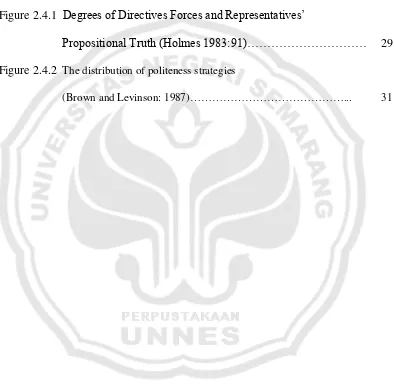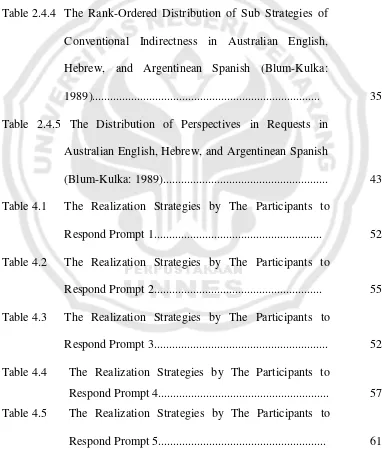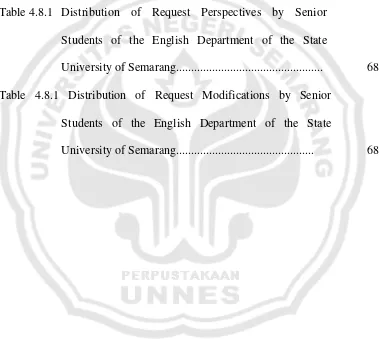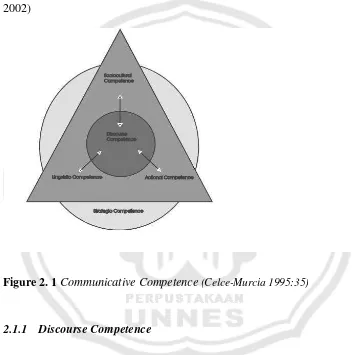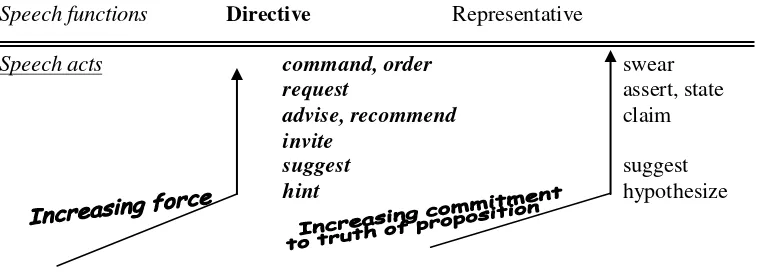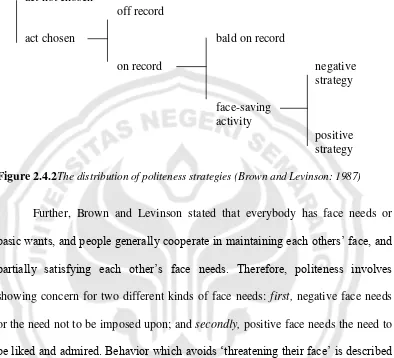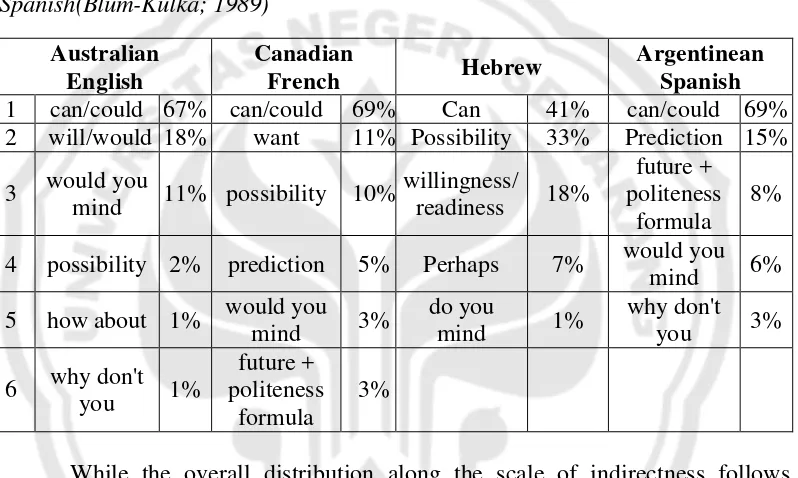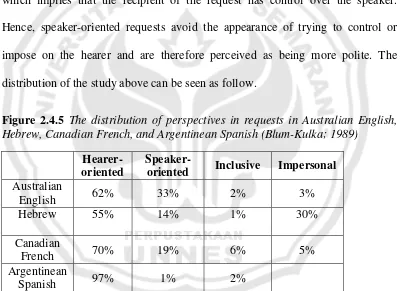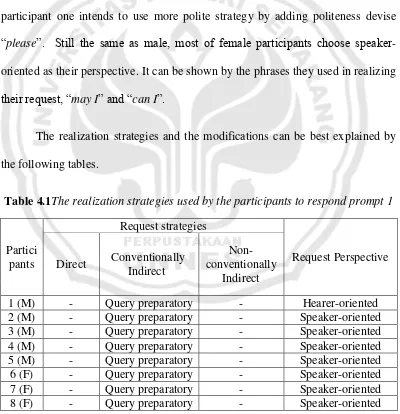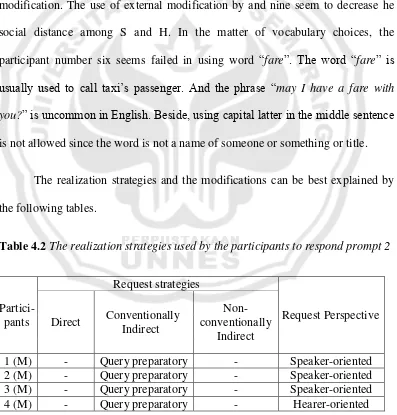OF THE SEMARANG STATE UNIVERSITY
a final projectSubmitted in partial fulfillment of requirements for the degree of Sarjana Pendidikan in English
by
Siti Nur Fithriyati 2201407048
ENGLISH DEPARTMENT
FACULTY OF LANGUAGES AND ARTS
SEMARANG STATE UNIVERSITY
ii
APPROVAL
This final project has been approved by the board of the examiners of the English
Department of the Faculty of Languages and Arts of UNNES on August 23, 2011.
The Board of Examiners
1. Chairman
Drs. Dewa Made K, M.Pd _________________
NIP. 195111181984031001
2. Secretary
Drs. Suprapto, M.Hum _________________
NIP. 195311291982031002
3. First Examiner
Dra. Sri Wuli Fitriati, M.Pd _________________
NIP. 197510262005012001
4. Second Examiner/Second Advisor
Dr. Dwi Anggani Linggar Barati M.Pd. _________________
NIP. 195901141989012001
5. Third Examiner/First Advisor
Dra. Sri Suprapti, M.Pd. _________________
NIP. 195911241986032001
Approved by
Dean of FBS
iii
PERNYATAAN
Dengan ini saya,
Nama : Siti Nur Fithriyati
NIM : 2201407048
Prodi/Jurusan : Pendidikan Bahasa Inggris/Bahasa Inggris
Fakultas : Bahasa dan Seni Universitas Negeri Semarang
menyatakan dengan sesungguhnya bahwa skripsi yang berjudul:
THE REALIZATION STRATEGIES OF REQUESTS BY SENIOR STUDENTS OF THE ENGLISH DEPARTMENT OF THE STATE
UNIVERSITY OF SEMARANG
yang saya tulis dalam rangka memenuhi salah satu syarat untuk memperoleh
gelar sarjana benar-benar merupakan karya saya sendiri yang saya hasilkan
setelah melakukan penelitian, pembimbingan, diskusi, pengaraan, dan ujian.
Semua kutipan baik yang langsung maupun tidak langsung, baik yang diperoleh
dari sumber kepustakaan, wahana elektronik, maupun sumber lainnya, telah
disertai keterangan mengenai identitas sumbernya dengan cara yang lazim
sebagaimana dalam penulisan karya ilmiah. Dengan demikian walaupun tim
penguji dan pembimbing skripsi ini membubuhkan tanda tangan sebagai
keabsahannya, seluruh isi karya ilmiah ini tetap menjadi tanggung jawab saya
sendiri, jika kemudian ditemukan ketidakberesan, saya bersedia menerima
akibatnya.
Demikian, harap pernyataan ini dapat digunakan dengan seperlunya.
Semarang, 12 Juni 2011
Yang membuat pernyataan,
Siti Nur Fithriyati
iv
Only as high as I reach can I grow,
Only as far as I seek can I go,
Only as deep as I look can I see,
Only as much as I dream can I be.
Karen Ravn
To
ALLAH, Your love endures forever
My Parents, for the incessant teaching
My Brother and Grandma, for the joyness
v
ACKNOWLEDGEMENTS
Foremost, I praise ALLAH the Almighty, the Gracious for His blessing upon me
in the form of inspiration, spirit, strength, caring, guidance and hopes during the
completion of my final project. My special thanks goes to my beloved mother,
father, and brother who provide the biggest support for me to do my best.
I would like to express my sincere gratitude to my first adviser, Dra. Sri
Suprapti, M.Pd. for her inspiring suggestions and advice during the completion of
the study. I am also indebted to my second adviser, and the Head of the English
education, Dr. Dwi Anggani Linggar Barati M.Pd., and all my lecturers for all
their never ending guidance given to me. My appreciation also goes to the Head
of English Department, Drs. Ahmad Sofwan, Ph.D, for the help during the
completion of my study.
Last but not least, I want to thank all my friends for their excellent
encouragement.
vi
ABSTRACT
Fithriyati, S.N. 2011. A Final Project. The Realization Strategies of Requests by Senior Students of The English Department of The State University of Semarang. English Department. Languages and Arts Faculty. Semarang State University. The first adviser: Dra. Sri Suprapti M.Pd, the second adviser: Dr. Dwi Anggani Linggar Barati M.Pd.
Key Words: realization strategies, requests, sociolinguistic, face-threatening acts The study aimed at describing the use of request strategies by senior students of the English Department of the State University of Semarang by focusing on how they produced the request. Requests are face-threatening acts requiring politeness strategies affected by various factors. It is not an easy task for language learners to perform requests in linguistically, socially and culturally appropriate manners.
The data were taken from the participants‟ realization strategies of requests in certain situations consisting of seven different situations in which each situation was supposed to have different social distance, degree of imposition, gender, and power in the form of written elicitation. The elicitation prompts were given in Bahasa Indonesia in the purpose of avoiding misunderstanding. The data analysis was done qualitatively by means of describing the requests using request strategies proposed by Blum- Kulka et al (1989).
The findings indicated that EFL learners tend to use conventionally indirect strategy to realize their requests in which the interrogative form is mostly used. The findings also showed that the higher power the participants have, the more direct request strategies used to convey their requests. The more social distance the participants have to the addressee, the more indirect request strategies are used, and the higher degree of imposition of the request, the more indirect the requests are used. However, there are no any big differences between male and female participants, but females tend to use more indirect request to lower power addressee than males Although, females consider more direct to the addressee who have the same power. They tend to make internal modification which is within the head act of requests. From the discussion I can also conclude that the participants of the study who are EFL advanced learners failed to show control over a wide range of forms and performing requests.
vii
TABLE OF CONTENTS
page
Acknowledgement………... vi
Abstract………. vii
Table of Contents……….. viii
The List of Figures……… x
The List of Tables………. xii
The List of Appendices………. xiv
CHAPTER 1. INTRODUCTION……… 1
1.1 Background of the Study………. 1
1.2Reasons for Choosing the Topic……….. 7
1.3Research Questions………. 8
1.4Purpose of the Study………... 9
1.5Significance of the study……… 9
1.6 Definition of Terms………. 9
1.7Organization of the Report………. 12
2. REVIEW OF RELATED LITERATURE………... 13
2.1Communicative Competence……….. 14
viii
2.1.2 Linguistic Competence……….... 17
2.1.3 Sociocultural Competence………... 18
2.1.4 Actional Competence………... 20
2.1.5 Strategic Competence………... 21
2.2Sociolinguistics... 22
2.3Pragmatics………... 25
2.4 Requests……….. 28
2.4.1 Politeness Strategies in Face Threatening Acts………... 30
2.4.2 Requests Strategies……….. 34
3. METHOD OF INVESTIGATION ……… .. 45
3.1 Approach of the Study……… 45
3.2 Participants of the Study………. 46
3.3 Types of the Data……… 46
3.4 Unit of Analysis……….. 46
3.5 Data Collection……… 46
3.6 Data Analysis………... 47
4. FINDINGS AND DISCUSSION……….... 48
4.1 Responses to Prompt 1……… 48
4.1.1 Male-Male Interactions………. 48
4.1.2 Female-Female Interactions……….. 49
4.2 Responses to Prompt 2………. 50
4.2.1 Male-Female Interactions………. 50
ix
4.3 Responses to Prompt 3……… 53
4.3.1 Male-Female Interactions………. 53
4.3.2 Female-Male Interactions………. 54
4.4 Responses to Prompt 4……… 56
4.4.1 Male-Male Interactions……… . 56
4.4.2 Female-Male Interactions………. 57
4.5 Responses to Prompt 5………. 59
4.5.1 Male-Male Interactions……… 59
4.5.2 Female-Female Interactions………. 60
4.6 Responses to Prompt 6……… 62
4.6.1 Male-Female Interactions……… 62
4.6.2 Female-Female Interactions………. 63
4.7 Responses to Prompt 7……… 65
4.7.1 Male-Male/Male-Female Interactions………. 65
4.7.2 Female-Female/Female-Male Interactions……….. 65
4.8 The Distribution of the Realization strategies………. 67
5. CONCLUSIONS AND SUGGESTIONS……….. 69
5.1 Conclusions……….. 69
5.2 Suggestions………... 71
REFERENCES……….. 72
x
THE LIST OF FIGURES
Figure page
Figure 2.1 Communicative competence (Celce-Murcia et al. 1995: 35)…. 16
Figure 2.4.1 Degrees of Directives Forces and Representatives‟
Propositional Truth (Holmes 1983:91)……… 29
Figure 2.4.2 The distribution of politeness strategies
xi
THE LIST OF TABLES
Table page
Table 2.4.3 The Distributions of Main Strategy Types in
Australian English, Canadian French, Hebrew, and
Argentinean Spanish (Blum-Kulka: 1989)... 34
Table 2.4.4 The Rank-Ordered Distribution of Sub Strategies of
Conventional Indirectness in Australian English,
Hebrew, and Argentinean Spanish (Blum-Kulka:
1989)... 35
Table 2.4.5 The Distribution of Perspectives in Requests in
Australian English, Hebrew, and Argentinean Spanish
(Blum-Kulka: 1989)... 43
Table 4.1 The Realization Strategies by The Participants to
Respond Prompt 1... 52
Table 4.2 The Realization Strategies by The Participants to
Respond Prompt 2... 55
Table 4.3 The Realization Strategies by The Participants to
Respond Prompt 3... 52
Table 4.4 The Realization Strategies by The Participants to
Respond Prompt 4... 57
Table 4.5 The Realization Strategies by The Participants to
xii
Table 4.6 The Realization Strategies by The Participants to
Respond Prompt 6... 64
Table 4.7 The Realization Strategies by The Participants to
Respond Prompt 7... 66
Table 4.8 Distribution of Request Strategies by Senior Students
of the English Department of the State University of
Semarang... 68
Table 4.8.1 Distribution of Request Perspectives by Senior
Students of the English Department of the State
University of Semarang... 68
Table 4.8.1 Distribution of Request Modifications by Senior
Students of the English Department of the State
xiii
THE LIST OF APPENDICES
Appendix page
Appendix 1 The Participants Personal Data……… 68
Appendix 2 The Elicitation Prompts………... 69
Appendix 3 The Elicitation Prompts Classification of Situations According to The Contextual and Situational
Variables……….. 70
1
CHAPTER I
INTRODUCTION
Requests are face-threatening acts requiring politeness strategies affected by
various factors. It is not an easy task for language learners to perform requests in
linguistically, socially and culturally appropriate manners. Therefore the present
study is conducted. The focus of the study is in the request strategies that the
participants used in conveying their request in different degree of imposition, with
people from different social distance, gender, and power.
1.1
Background of the Study
The ultimate goal of language teaching and learning is communicative
competence. The communicative competence deals with linguistics competence
in which the rules for describing sound systems and for combining sounds into
morphemes and morphemes into sentences is explained (Hymes: 1972). He also
argued that one also needed notion of Sociolinguistic Competence that is the rules for using language appropriately in context, to account for language
acquisition and language use. Hall (2002: 2) proposed that language is considered
to be a set of abstract systems whose meanings reside in the forms themselves
Further the Hymes‟ perspective about communicative competence is than
become part of the theoretical justification for a new language teaching approach
and new teaching materials that were compatible with communication as the goal
of second or foreign language teaching (Celce-Murcia: 2007).Previously, linguists
have traditionally focused their attention primarily on the internal properties of
languages, on how meaning is formally encoded in lexis and grammar (semantic
meaning). In semantics, the focus is mostly on meaning which is relatively fixed
and does not vary with context. In addition, meaning is seen as a link between
linguistic forms and concepts held in the mind.
In the development of communicative competence, Celce-Murcia et al.
(1995) proposed that Actional Competence, which is the ability to comprehend
and produce all significant speech acts and speech act sets, should be part of
communicative competence. Actional competence, than became a part of
sociolinguistic competence together with Sociocultural Competence. Sociocultural competence refers to the speaker‟s pragmatic knowledge, i.e. how
to express messages appropriately within the overall social and cultural context of
communication. Pragmatic is the study of the use of language in society and the
myriad factors that influence (Levinson, 1983; Thomas, 1995). Celce-Murcia et
al. (1995: 23-24) described that there are three crucial factors in term of
Sociocultural Competence. The first social contextual factors which covers the participant‟s age, gender, status, social distance, and their relations to each other.
Then they also proposed a term of stylistic appropriateness that is the politeness
3
background knowledge of the target language group, major dialects/region
differences and cross cultural awareness. According to the brunches of
Communicative Competence, communication is not only built by one component,
i.e. grammar, but also needs others component in order to make communication
run well.
Both Actional Competence and Sociocultural Competence provide
communicators appropriate language use and also clues to correct interpretation
of utterances. What is considered polite in a given context may be viewed as
sarcastic or hostile in other. For instance elaborate forms of requests beginning
with „I was wandering if I could...‟, or „Would you please be kind enough to...?‟
are only appropriate in formal situations and addressed to unfamiliar people or
those who differ in rank or those whose willingness to comply is in doubt, while
they are not the case in informal situation involving people in intimate relation.
Yet, such forms are used in the latter when the degree of imposition is perceived
to be demanding against the addressee. Such complex aspects clearly indicate that
„there are rules of use without rules of grammar would be useless‟ (Hymes, 1971)
as cited by Suprapti (2003).
The first example above „I was wandering if I could...‟, or „Would you
please be kind enough to...?‟ are the expressions that very appropriate in formal
situation, no matter how close the speaker and hearer is because the situation
demands the communicators in such a formal situation. It means that language
varies not only according to who is speaking – its users – but also according to the
particular context and the notion of register provides us with a way of talking
about the relationship of language to its context of situation. Utterances have to be
appropriate to their context. Experienced users of a language are able often to
identify a typical context for any utterance from small textual cues. (Montgomery
and Helen, 1994). In such situation a speaker might say „It’s too cold in here‟, but
actually what the speaker‟s mean might be „Please turn off the air conditioner!‟
because the communicators are in a room which has an air conditioner.
Nevertheless, the speaker might want to request the hearer to close the door,
because the weather is cold and the hearer forget to close the door. The other
possible intention that might be implicit in the example above is „please, give me
my jacket‟ because the speaker is in a cold camping area at night and he can take
his jacket by himself. Thus, the registers or situation also has a part in
determining the meaning of an utterance.
The examples above are the examples of request in which conveyed in
indirect way. The choice of request strategies directly affects how face-threatening the speech act will be, making a request is an especially delicate proposition. According to Brown and Levinson (2006) the term of
face-threatening acts deal with the utterances which challenge either a person‟s
positive face(with disapproval or contempt) or negative face (through a request
for action which impinges upon a person‟s freedom from imposition). Consider
the differences between the following: (a) ‘Close the window!’; (b) ‘Close the
window, please!’; (c) ‘Could you please close thewindow?’; (d) ‘Could you close
5
show the diverse strategies for approaching a face-threatening act, different
degree of politeness, and thus varying kinds of corresponding the indirectness (or
in the first example is directness). Many times, the strategies of conveying request
are influenced by sociocultural norms, such as status, gender, social distance,
power, and/or environment or situation. In some cultures, more important is
placed on a person‟s status, age, or social distance than in others. Therefore, the
degree of directness used in request may differ based on these sociocultural
standards. (Tatton, 2008)
The notions of indirectness and politeness play a crucial role in the
negotiation of face during the realization of speech act such as request. A request
is a directive act and a pre-event which initiates the negotiation of face during a
conversational interaction. According to Brown and Levinson (1987), request is
intrinsically face threatening because they are intended to threaten the addressee
negative face (i.e. freedom of action and freedom from imposition). Following
their model of politeness, while request may be realized by mean of linguistic
strategies such as on record (e.g., direct and unmitigated) or off record (e.g., hint,
and irony), a compromise may be reached by the speaker using indirect request.
According to Searle (1975: 60-61), in indirect speech act “the speaker
communicate to the hearer more than he actually says by way of relying on their
mutually shared background information, both linguistic and non-linguistic,
together with the rational powers of rationality and inference on the part of the
there is a preference for indirectness in the part of the speaking issuing to request
to smooth the conversational interaction.
It has been observed that higher level of indirectness may result in higher
level of politeness. According to Brown and Levinson (1987) and Leech (1983)
direct request appear to inherently impolite and face threatening because they
intrude in the addressee‟s territory, and these authors argued that the preference
for polite behaviour is indirectness. Leech (1983: 131-132) suggested that it is
possible to increase the degree of politeness by using more indirect illocutions:
„(a) because they increase the degree of optionally, (b) and because the more
indirect of illocution is, the more dismissed and tentative its force tends to be‟.
Based on Blum-Kulka (1989: 42), indirectness is comprised of two types:
conventional indirectness (CI), which center in conventions of language including propositional content (literal meaning) and pragmalinguistics form used
to signal an illocutionary force, and Non-Conventional Indirectness (NCI), which relies heavily in context and tends to be „open-ended, both in term of
prepositional content and linguistic form as well as pragmatic force‟. The link
between indirectness and politeness is further supported by Searle‟s observation
that „politeness is the most prominent motivation for indirectness in request, and
certain forms tend to become the conventionally way of making indirect requests‟.
(1975: 76).
Giving requests are face - threatening acts, and that the use of politeness
strategies is affected by various factors, it would not be an easy task for language
7
manners. They should not only have sufficient linguistic resources to encode a
request, but also know sociocultural rules that affect their choice of politeness
strategies in a given situation with taking into account a variety of situational
factors. (Suh 1999: 196).
Since the focus of language studies in second and foreign language
teaching and learning of English is on grammatical competence of the language
learners at the level of phonology, morphology, and syntax, the communicative
competence in using English will not be covered in whole. Thus, the pedagogical
challenge lies in the fact that second and foreign language teachers typically have
far greater awareness and knowledge of linguistic rules than they do of the
sociocultural behaviors and expectations that accompany the use of language in
the target language. Nevertheless, the teachers should be realizing that even if
good cultural descriptions are available, it is hard to get learners to change their
native verbal behavior based on a new set of assumptions. Therefore, the present
study is conducted. The focus of the study is in the request strategies that the
participants used in conveying their request in different degree of imposition, with
people from different social distance, gender, and power.
1.2
Reasons for Choosing the Topic
I choose the topic “The Realization Strategies of Request by Senior Students of
The English Department of The State University of Semarang” owing to the facts
(1) Native speakers of English tend to use indirectness in conveying requests.
It is a fact which in itself requires some explaining. Second and foreign
language learners should be aware of this phenomenon.
(2) Most second and foreign language learners face problems to interpret and
react to use direct and indirect requests strategies appropriately. Therefore
they need to see what strategy that they use in communication whether it
is appropriate or not.
(3) Teaching and learning process of English as foreign language in
Indonesia is focused on grammatical competence of the language learners
at the level of phonology, morphology, and syntax. Hence, the learners
under study are more aware of linguistic competence than sociolinguistic
competence. In fact, when they use language, the sociolinguistic
competence has a big influence in determining whether the
communication will be succeed. The present study will show how
sociolinguistic competence affects the choice of request strategies in
communication.
1.3
Research Questions
Having found the general background of the problem as stated above dealing with
the realization strategies of requests by English Department of Semarang State
9
(1) How does the English Department of Semarang State University
students on senior years realize their requests?
(2) Do the sociolinguistics competence aspects (social distance, gender,
degree of imposition, and power) affect the students‟ request
strategies?
1.4
Purpose of the Study
In line with the research questions, the present study is aimed:
(1) To figure out how the participants of English Department of
Semarang State University students on senior years realize their
request strategies.
(2) To figure out whether the sociolinguistic competence aspects (social
distance, gender, degree of imposition, and power) affect the students‟
request strategies.
1.5
Significance of the Study
The findings of the study are expected to provide input to: (1) foreign language
learners of English as a source of being open minded towards request strategies,
especially when they are preparing to have conversations with NSs, (2) lecturers
important in communication, (3) education institutions to arrange a better
standard competence which not only focused on linguistic competence but also
the sociolinguistic competence, and (4) book writers as a reference when they
deal with request strategies.
1.6
Definition of Terms
1.6.1. Communicative competence is a language user's grammatical knowledge
of syntax, morphology, phonology and the like, as well as social
knowledge about how and when to use utterances appropriately.
1.6.2. Conventionally indirect request strategy is request strategy which is
referring to contextually preconditions necessary for its performance as
conventionalized in the language.
1.6.3. Degree of imposition is a culturally and situationally defined ranking of
impositions by the degree to which they are considered to interfere with an
agent's wants of self-determination or of approval (negative and positive
face wants).
1.6.4. Descriptive qualitative is a research which requires some descriptive as the
research of data analysis.
1.6.5. Direct request strategy is a request strategy in whish the request is marked
explicitly as requests.
1.6.6. EFL learners a person who use or study of English with a different native
11
1.6.7. Elicitation is the term applied to subtle extraction of information during an
apparently normal and innocent conversation.
1.6.8. Face-threatening act (FTA) is any utterances which could be regarded as
making demand or intruding on another person‟s anatomy.
1.6.9. Gender is a set of characteristics distinguishing between male and female,
particularly in the cases of men and women.
1.6.10.Lerner is a person who is learning e.g. student; pupil; apprentice; trainee
affecting the whole.
1.6.11.Linguistic competence is the rules for describing sound systems and for
combining sounds into morphemes and morphemes into sentences is
explained.
1.6.12.Non-conventionally indirect strategy or hints is request strategy which is
partially referring to the object depending on contextual clues.
1.6.13.Politeness strategies are communicative devices for redressing the threats
inherent in verbal and nonverbal utterances.
1.6.14.Power is a possession of the qualities (especially mental, qualities) required
to do something or get something done.
1.6.15.Pragmatics is meaning in use and meaning in context.
1.6.16.Prompt is quick or ready to act or respond to serve as the inciting cause of.
1.6.17.Realization is a subtask of natural language generation, which involves
creating an actual text in a human language (English, French, etc) from a
1.6.18. Request is a prevent act that expresses a speaker‟s expectation about some
prospective action, verbal, or non-verbal on the part of the hearer.
1.6.19. Request strategy is a speaker‟s strategy in making request.
1.6.20.Senior year student is someone who attends an educational institution on
the last year.
1.6.21.Student is someone who attends an educational institution.
1.6.22.Social distance is the perceived distance between individuals or groups.
1.6.23.Sociolinguistic competence is the rules for using language appropriately in
context, to account for language acquisition and language use.
1.7
Organization of the Report
This final project consists of five chapters. Chapter one introduces the
backgrounds, statement of the problems, purpose of the study, significance of the
study, reasons for choosing the topic, and definition of terms, chapter two
presents the review of some related literature, chapter three describes the
methodology, chapter four presents the research findings and the discussion while
13
CHAPTER II
REVIEW OF RELATED LITERATURE
Communicative competence is a term coined by the anthropological linguist Dell Hymes in 1967 who put toward this notion in response in the theories of the
formal linguists Noam Chomsky, who focused on linguistic competence and
claimed that any consideration of social factors was outside the domain of
linguistics. Hymes (1972) argued that in addition to linguistic competence (the rules of describing sound system and for combining sounds into morphemes and
morphemes into sentences), one also needed notions of sociolinguistic competence (the rules for using language appropriately in context) to account for language acquisition and language use. Since the term of communicative
competence was presented, many linguists adopted Hymes‟ terminology and
perspective, and his notion of communicative competence which become part of
the theoretical justification for a new language teaching approach and new
teaching materials that were compatible with communication as the goal of
second or foreign language teaching. Hereafter, the focus of teaching language as
second and foreign language is to reach that goal that is to make the learner able
to communicate in appropriate ways. That means that the learners should be able
to develop discourse. Thus, the core of communicative competence is discourse
competence.
In order to reach the communicative competence, one should include all of
the communicative competence, in which Celce-Murcia et al. proposed five
competences and the discourse competence as the core of communicative
competence. The model proposed by Celce-Murcia et al. is the development of
the Hymes model of communicative competence. Those competences are
sociocultural competence, discourse competence, linguistic competence, actional
competence, strategic competence. Based on Celce-Murcia et al (1995), there are
many competences to maintain communication to run well. It can be the social
contextual factors, stylistic appropriateness, cultural factors, cohesion, diexis,
coherence, generic structure, phonological, lexical, morphological, syntactic,
routines, collocations, idioms, lexical frames, speech acts, turn-taking system,
non-verbal or paralinguistic system, cogitative and metacognitive system.
This Chapter covers the Communicative Competence and its branches,
there are Discourse Competence, Linguistic Competence, Sociocultural
Competence, Actional Competence, and Strategic Competence. Sociolinguistic,
15
2.1
Communicative Competence
As described above, the term of communicative competence is proposed as the
alternative to the concept of linguistic competence as first presented by Chomsky
(1965, 1966). At first, Chomsky proposed the concept of linguistic competence to
capture the principles of universal grammar, conditions and rules for generating
the structural components of a language, which any speaker of a language know
implicitly. For Hymes as cited by Hall (2002: 105), Chomsky‟s definition of
language knowledge could not account for the knowledge and skills that the
individuals must have to understand and produce utterances appropriate to the
particular cultural contexts in which they occur. He defined that in terms of both
the knowledge and ability that individuals need to understand and use linguistic
resources in ways that are structurally well formed, socially and contextually
appropriate, and culturally feasible in communicative contexts constitutive of the
different groups and communities of which the individuals are members.
Hymes defined communicative competence in term of four dimensions.
The first, systemic potential is knowledge of and ability to use the generative base
of language. The second dimension is appropriateness, defined as knowledge of
language behaviour and its contextual features and the ability to use language
appropriately. The third is occurrence which Hymes defined as knowledge of
whether and to what extent action is taken with language to take such action. The
last dimension is feasibility, which includes knowledge of whether and to what
appearance in applied linguistics, others have attempted to use the concept of
communicative competence, and its underlying theory of language, to construct
frameworks for the design of language curricula and test. One of the more
comprehensive frameworks to date is that by Celce-Murcia et al. (1995). Their
model, depicted in figure 2.1, consist of five interrelated areas of competence:
discourse, linguistic, actional or rhetorical, sociocultural, and strategic. (Hall,
2002)
Figure 2. 1 Communicative Competence (Celce-Murcia 1995:35)
2.1.1 Discourse Competence
On the model of communicative competence proposed by Celce-Murcia et al.
(1995), the authors as cited by Hall (2002) define discourse competence as the
core of communicative competence. It includes not only knowledge of and the
17
and written texts. It also includes knowledge of and the ability to use
conversations for taking turns, holding on to the conversational floor interrupting
and providing listener feedback cues such as „umm‟ and „uh huh‟. They argued
that discourse competence deals with the selection, sequencing, and arrangement
of words, structures, and utterances to achieve a unified spoken message. This is
where the top-down communicative intent and sociocultural knowledge intersect
with the lexical and grammatical resources to express messages and attitudes and
to create coherent text. They described several sub-areas of discourse competence,
four of which are most important with regard to current model:
a. cohesion: conventions regarding use of reference (anaphora/cataphora),
substitution/ellipsis, conjunction, and lexical chains.
b. deixis: situational grounding achieved through use of personal pronouns,
spatial terms, temporal terms, and textual terms.
c. coherence: expressing purpose/intent through appropriate content schemata,
managing old and new information, maintaining temporal continuity and other
organizational schemata through conventionally recognized means.
d. generic structure: formal schemata that allow the user to identify an oral
discourse segment as a conversation, narrative, interview, service encounter,
report, lecture, sermon, etc.
Giving shaped to, and being shaped by, discourse competence is three
additional competences. There are linguistic competence, actional or rhetorical
2.1.2 Linguistic Competence
The first competence that is giving shaped to discourse competence is linguistic
competence, which consist of the basic elements of the linguistic system that are
used to interpret and construct grammatically accurate utterances and texts. This
also includes knowledge of and ability to use syntax, involving sentence, patterns,
word order, coordination, and subordination and embedding in addition to
morphology, phonology, vocabulary, and orthography. According to Hymes at
cited by Celce-Murcia et al. (2007), linguistic competence refers to the rules for
describing sound systems and for combining sounds into morphemes and
morphemes into sentences. The term of linguistic competence includes four types
of knowledge:
a. phonological: includes both segmentals (vowels, consonants, syllable types)
and suprasegmentals (prominence/stress, intonation, and rhythm).
b. lexical: knowledge of both content words (nouns, verbs, adjectives, adverbs)
and functional words (pronouns, determiners, prepositions, verbal auxiliaries,
etc)
c. morphological: part of speech, grammatical inflections, productive derivational
processes.
d. syntactic: constituent/phrase structure, word order (both canonical and
marked), basic sentence types, modification, coordination, subordination,
embedding
Linguistic competence is the main focus in teaching English as second or
19
communication run well, one should know aware with whom and from where he
talks to, so he can use the appropriate strategies in communication. Thus, the next
competence which linked to discourse competence will provide some component
that one should know in maintaining communication that is sociocultural
competence. This comprises the non-linguistic, contextual knowledge that
communicators rely on to understand and contribute to a given communicative
activity. This aspect competence includes knowledge of, ability to use, the rules,
norms and expectations governing the larger social context of the activity.
2.1.3 Sociocultural Competence
Sociocultural competence refers to the speaker‟s pragmatic knowledge, i.e. how
to express messages appropriately within the overall social and cultural context of
communication. This includes knowledge of language variation with reference to
sociocultural norms of the target language. In fact a social or cultural blunder can
be far more serious than a linguistic error when one is engaged in oral
communication (Celce-Murcia et al: 1995.). Celce-Murcia argued that the
pedagogical challenge lies in the fact that second and foreign language teachers
typically have far greater awareness and knowledge of linguistics rules than they
do of the sociocultural behaviors and expectations that accompany use of the
target language. Based on her perspective, even when good cultural descriptions
are available, it is hard to get learners to change their native verbal behaviour
Further, Celce-Murcia et al (1995: 23-24) described several sociocultural
variables, three of which are most crucial in terms of the current model.
a. Social contextual factors: the participants‟ age, gender, status, social distance
and their relations to each other.
b. Stylistic appropriateness: politeness strategies, a sense of genres and
registers.
c. Cultural factors: background knowledge of the target language group, major
dialects/regional differences, and cross-cultural awareness
She added that the above competencies can be acquired in part through some
knowledge of the life and traditions as well as knowledge of the history and
literature of the target language community. An extended living experience
among members of the target language group is probably the best experience for
language acquisition if the learner has adequate basic preparation in both
linguistic and sociocultural competence coupled with good powers of observation.
Both linguistic competence and sociocultural competence are the way we know
which strategy that may proper to communicate and how to form words into
sentences, so we can convey our intention to the hearer appropriately. Even so, we
cannot make a good communication and may cause the communication fail if we
do not know how to convey it well. Thus, the next component of communicative
competence is added by Celce-Murcia et al. in 1995 that is actional competence.
Based on Celce-Murcia et al (1995) actional competence refers to the ability to
21
2.1.4 Actional Competence
Also linked to discourse competence is actional or rhetorical competence.
Celce-Murcia et al. defined this component as the knowledge of and ability to match
actional intent with linguistic form based on the knowledge of an inventory of
verbal schemata that carry illocutionary force. Entailed here, therefore, is
knowing how to use language to do something, to perform certain functions, such
as making promise, giving orders, complaining and so on. It also involves
knowing how to combine individual acts into larger, meaningful sets of actions to
create an appropriate communicative activity such as making a purchase, setting
up an appointment, recounting a story and so on. When discussing written text,
Celce-Murcia et al. prefer the parallel term of rhetorical competence. This aspect
includes knowledge of the speech acts and speech act sets conventionally
associated with particular written grammar.
Celce-Murcia et al, (1995) added that nonverbal or paralinguistic aspects
of oral interactions are also crucial made which are rarely treated in the language
classroom. These conventions can overlap with those for conversational
turn-taking; for example an English speaker‟s body movements, in breaths, and eye
contact can result in a conversational turn for the person displaying such
non-verbal signals. Hence, all of the differences in communication should be solved in
order to participate in discourse, which is the main goal in communication. Thus,
the final component of Celce-Murcia et al.‟s model is strategic competence. It
includes the knowledge, skills and ability to resolve communicative difficulties
2.1.5 Strategic Competence
According to Oxford (2001:362) as cited by Celce-Murcia et al., strategies for
language learning and use are “specific behaviors or thought processes that
students use to enhance their own L2.” Such behaviors are either learning
strategies or communication strategies. We know that the learners who can make
effective use of strategies (i.e. who have strategic competence) tend to learn
languages better and faster than those who are strategically inept. There are some
terms that should be realized in strategic competence. There are:
a. cognitive: that is strategy in making use of logic and analysis to help oneself
learn a new language through outlining, summarizing, note taking, organizing
and reviewing material, etc.
b. metacognitive: this strategy involves planning one‟s learning by making time
for homework or for preparation, and engaging in self evaluations of one‟s
success on given task or on one‟s overall progress. This is achieved in part by
monitoring and one‟s errors, learning from teacher and peer feedback, etc.
Compansationing for missing or partial knowledge by guessing the meanings
of words from context or the grammatical function of words from formal clues
are also aspect of metacognitions.
c. memory-related: that is strategy that help learners recall or retrieve words
through the use of acronyms, images, sounds (rhymes), or other clues.
The other crucial strategies, which are highlighted by Celce-Murcia et al.
23
a. achievement: strategies of approximation, circumlocution, code switching,
miming, etc.
b. stalling for time gaining: using phrases like Where was I? Could you repeat
that?
c. self-monitoring: using phrases that allow for self repair. i.e. I mean...
d. interacting: this is strategy that include appeals for help/clarification, that
involve meaning negotiation, or that involve comprehension and confirmations
checks, etc.
e. Social: these strategies involve seeking out native speakers to practice with,
actively looking for opportunities to use the target language.
Hall (2002: 108) argued that the notion of communicative competence
helps us to see that language use involves not just knowledge of and ability to use
language forms, it also involves knowledge and to use language in ways that are,
to use Hymes‟ terms, socially appropriate, and feasible called for. That might be
the reason way Hymes added sociolinguistic competence in the beginning of
communicative competence development.
2.2
Sociolinguistic
Based on Stockwell (2002:5) as cited by Ilic (2004), sociolinguistic is one of
linguistic brunch which is supposed to investigate all aspect of the relationship in
the society as a whole. With the starting assumptions of the all languages event
context determines a particular form of language, the potential scope of
sociolinguistic is enormous. It studies how language is used in a speech and in
living and complex speech community, from micro sociolinguistic issuing dealing
with the correlations between language variations and use, and social groups and
situations to macro sociolinguistic issues such as social attitudes to language, the
patterns and needs of national language use, etc. The manifestation of language
variation are sometimes less obvious to identify distinctly. They include regional
dialects and social dialects, reflecting that in many communities it is possible to
tell from a person‟s speech not only where he comes from but also what class he
belongs to. There seems to be general tendency that the speech of the higher
classes demonstrates less regional variations.
Also important is gender-related language variation. There are various
ways in which linguistic behaviour of men and women from the same speech
community will differ in pronunciation, vocabulary, conversational practices, etc.
For example, several studies have found that women tend to be more polite, and
use more of the standard forms of language, which is frequently explained by
their social class awareness, their role in society of their status in general as a
subordinate group.
While these aspects of the socially relevant language variations focus
mostly on language users, their ethnicity, gender, social background, etc. There
are some aspects which primarily on language use, reflecting particular contexts.
The way people talk in court, in school, at business meetings, for instant, is more
25
well. Similar differences are noticeable when we speak to people of a different
age or social group. Such language variations are generally known as style, or
stylistic differences, although the term register is also used. Stylistic differences
have been mainly studied with reference to the addressee – their age or social
group. For sociolinguistic especially interesting has been the issue of politeness,
the notion develop by pragmatists (Brown and Levinson, 1987), which refers to
showing awareness of other people‟s public self image (face) and can be
manifested as positive (showing solidarity) or negative (accepting another‟s right
not to be imposed on). In communication speakers make appropriate linguistic
choices in the light of their relationship to the addressee, in order to make them
uncomfortable. In all societies, there are sociolinguistic rules for, for instance,
polite acceptance or refusal, greetings, request, conversation topics, forms of
address, and these differ cross-culturally. What is acceptable, even desirable
linguistic behavior in one society may be unsuitable, even taboo in another. These
differences may seem totally random, but they are actually closely connected with
different social values and attitudes of different societies. (Ilic 2004: 1-15).
The language use is more generally discussed in pragmatic area. As Ilic
argued the most general area of the study of language from the point of view of its
use is pragmatics. It is primarily concerned with language users – the choice they
make, the constrain they encounter in using language in social interaction, their
2.3
Pragmatics
In early 1980s, when it first became common to discuss pragmatics in general textbooks on linguistics, the most common definition of pragmatics was:
meaning in use or meaning in context. Although these definitions are accurate enough and perfectly adequate as a starting point, they are too general – for
example, there are aspects of semantics, particularly semantics of the type
developed since the late 1980s, which could well come under the headings of
meaning in use or meaning in context. More up-to-date textbooks tend to fall into
one of two camps – those who equate pragmatics with speaker meaning and those who equate it with utterance interpretation (Thomas 1995: 2).
Thomas (1995: 21), however, criticized those two camps. She argues that
the former camp was concerned primarily or exclusively with speaker intention
and focuses on the speaker or producer of talk to the near exclusion of the hearer
or receiver of talk. It must be obvious that for the speaker ambiguities of sense,
reference or structure rarely, if ever, exist. In contrast, those who operate the
utterance interpretation definition of pragmatics focus almost exclusively on the
process of interpretation from the point of view of the hearer. Their focus on the
way in which hearers reach a particular interpretation is accompanied by a refusal
to take account of the social constraints on the utterance production. Therefore, in
this study I work toward the definition of pragmatics as meaning in interaction. This reflects the view that meaning is not something which is inherent in the
27
Making meaning is the dynamic process, involving the negotiation of meaning
between speaker and hearer, the context of utterance (physical, social, and
linguistic) and the meaning potential of an utterance (Thomas 1995: 22).
Utterances not only have sense but also force. Austin as quoted by Thomas (1995:49) made three-fold distinction:
Locution : the actual words uttered;
Illocution : the force or intention behind the words; Perlocution : the effect of the illocution on the hearer.
For example, I might say: It’s too cold in here! (Locution), meaning:
Please turn off the air conditioner! (Illocution) and the perlocutionary effect will
be that my addressee turns off the air conditioner. Part of the problem stems from
the fact that the same locution could have a different illocutionary force in
different contexts. E.g. What time is it? could depending on the context of
utterance mean any of the following:
The speaker wants the hearer to tell the time; The speaker is annoyed because the hearer is late; The speaker thinks it is time the hearer went home; (Thomas 1995:50).
Further, Richards (1995: 16) as cited by Hermasari (2009) contends that if
all we did in using language was to say something, the theory of pragmatics
would have to deal only with the issues such as: notions of literal/figurative
intention, specifying of indexical, and resolving which leg of an ambiguity was
meant. However, we do much more. We intend what we say to have a specific
force. We make requests, make promises, make offers, etc which are called
used the term „speech acts‟ to refer to an utterance and the total situation in which
the utterance is issued. Today the term speech acts is used to mean the same as
illocutionary acts – in fact, you will find the terms speech act, illocutionary act,
illocutionary force, pragmatic force or just force, all used to mean the same thing. In line with Austin, Searle (1980: vii) contends that the speech acts theory
(SAT) starts with the assumption that the minimal unit of human communication
is not a sentence or other expression, but rather the performance of certain kinds
of acts, such as making statements, asking questions, describing, etc. which are
called illocutionary acts.
Close sight to naturally occurring conversation brings the fact that the
same words can be used to perform different speech acts, vice versa different
words can be used to perform the same speech act. The following utterances
illustrate different ways of performing the speech act of requesting someone to
close the door:
Shut the door!
Could you shut the door? Did you forget the door? Put the wood in the hole. Were you born in a barn?
What do big boys do when they come into a room, Johnny? (Thomas 1995: 51)
In addition, Grundy (1995: 12) as cited by Hermasari (2009) argues that
because pragmaticists are interested in the meaning of utterances, they are also
29
reflect context is in our use of politeness phenomena. For example, we know that: Could I just borrow a tiny bit of paper is a way of lessening a request, and
must more likely to be acceded than: Give me a sheet of paper.
2.4
Requests
The last two examples above („could I just borrow a tiny bit of paper?’ and „give
me a sheet of paper‟? are conveyed by the speaker to expect some hearer action.
Thus, in line with Blum-Kulka, Danet, and Gherson (1985) that mentioned a
request as a prevent act that expresses a speaker‟s expectation about some
prospective action, verbal, or non verbal on the part of the hearer. In other
perspective, Searle (1976) as quoted by Hymes (1983: 93) includes request as
directive speech acts. He argued that suggestions, requests, and command which
primarily function is that count as attempts by the speaker (S) to get the hearer
(H) to do something. They only differ in the force of attempt. The goals of
requests include action (e.g. Can you open the window?), goods (e.g. Can you
pass me the salt), information (e.g. Do you know who our teacher is going to be
this semester?, and permission (e.g. May I leave early?), and the appropriateness
of a particular goal which is determined by the social norms in which the speech
acts are made.
Holmes ranks the differing forces of directive and representative speech
Speech functions Directive Representative
Speech acts command, order swear
request assert, state
advise, recommend claim
invite
suggest suggest
hint hypothesize
Figure 2.4.1Degrees of Directives Forces and Representatives’ Propositional Truth (Holmes 1983:91)
The complexity of directives is not only raised from its force of attempts.
The preceding examples show various forms as directives realization which also
takes part in its complexity.
To account for the choice of directive forms, Ervin-Trip (1972) as cited by
Hatch (1995: 122) found it helpful to classify directives into five types that
include the relationship between the speaker and addressee roles:
a. Personal need/desire statements
Example : I need/want X.
Addressee : Subordinates.
b. Imperative
Example : Gimme X.
Addressee : Subordinates or familiar equals.
c. Imbedded imperative
[image:43.595.113.495.113.249.2]31
Addressee: Unfamiliar people; people who differ in rank or who are
physically distant; someone who is in his or her territory;
someone who is willingness to comply is in doubt.
d. Permission directive
Example : May I have X? Is there any X? Do you have X?
Addressee: Someone who might not comply (upward more often than
downward in rank); also used when there is an obstacle to
compliance.
e. Question directives
Example : Have you got a match?
Addressee: Someone who might not comply, so the question turns on the
likely obstacle.
f. Hint (sometimes with humor)
Example : This has to be done over. What about X?
Addressee: Persons with shared rules such as members of a family, people
living together, and work groups.
Both situational and cultural factors influence use of these request
strategies. Different cultures seem to agree on general trends of situational
variation. For example, a big favor usually comes with more indirect and/or polite
strategies than a low-imposition request. Friends use more casual requests than
acquaintances provided that the content of the request is the same. However, the
specific directness levels appropriate for given situations might differ
other languages equally in an appropriate manner within the culture. Because the
choice of request strategies directly affects how face-threatening the speech act
will be, making a request is especially delicate preposition. Thus, request
strategies link to the choice of politeness strategies the speaker chooses in
conveying request.
2.4.1 Politeness Strategies in Face Threatening Acts
According to Brown and Levinson (1987), politeness strategies are communicative devices for redressing the threats inherent in verbal and nonverbal
utterances. Generally, politeness strategies are divided into two, positive politeness which aims to protecting the individual‟s desire to be evaluated positively, for example by expressing admiration for the addressee; and negative politeness which accounts for the individual‟s desire to act free from impositions, for example, by emphasizing that the final decision is up to the addressee. Brown
and Levinson (1978: 101-227) developed a model of politeness, in which they
distinguish a number of options or „strategies‟ available to the speaker. First, the
speakers can choose to perform the act or not to perform it. If the act is
performing it can be „off-record‟ or „on-record‟. On –record acts can be baldly on
record or can involve „face-saving activity‟. The latter can take the form of a
„positive strategy‟ or a „negative strategy‟. The former involves some kind of
attempt to establish solidarity with the addressee by emphasizing commonality. It
likely occurs when there is minimal social distance and little power difference
between the participants. A negative strategy involves performing the act in such
33
way out of compliance with the act. It is used when the power difference between
the participants is considerable. The schematic representation of Brown and
Levinson‟s (1978) politeness model bellows will explain the politeness strategy.
act not chosen
off record
act chosen bald on record
on record negative
strategy
face-saving activity
[image:46.595.116.510.206.564.2]positive strategy
Figure 2.4.2The distribution of politeness strategies (Brown and Levinson: 1987)
Further, Brown and Levinson stated that everybody has face needs or
basic wants, and people generally cooperate in maintaining each others‟ face, and
partially satisfying each other‟s face needs. Therefore, politeness involves
showing concern for two different kinds of face needs: first, negative face needs
or the need not to be imposed upon; and secondly, positive face needs the need to
be liked and admired. Behavior which avoids „threatening their face‟ is described
as evidence of negative politeness, while sociable behavior expressing warmth towards an addressee is positive politeness behavior (Brown and Levinson 1987 as cited by Holmes (1995: 5).
Thus, the choice of request strategies is tightly correlated to this term as
Holmes (1995: 5) proposes that any utterance which could be interpreted as
face-threatening acts (FTA), i.e. suggestions, advice and requests can be regarded as face-threatening acts, since they are potentially impede the other
person‟s freedom. Further, she contends that polite people avoid obvious face
-threatening acts, such as insult and orders; they generally attempt to reduce the
threat of unavoidable face threatening acts such as requests or warning by
softening them, or expressing them indirectly; and they use positively polite
utterances such as greetings and compliments where possible.
Different cultural and linguistic groups express politeness differently,
therefore, we can say that politeness strategies are „culture dependent‟. The
preceding example of politeness strategy used by native speaker of Arabic,
Yiddish, Farsi, Indonesian, or Japanese, i.e. the tendency of refusing some offer
(e.g. meal) as an initial response which must not be taken literally since it may
mean that the offer should be repeated more insistently, shows the crucial of
culture towards the interpretation of politeness strategies.
According to Brown and Levinson, if an FTA is unavoidable so that
speaker has to perform it, thus, there are four possibilities:
a. Perform the FTA on-record (bald-on-record);
b. Perform the FTA on-record without redness using positive politeness;
c. Perform the FTA on-record with redness using positive politeness;
d. Perform FTA using off-record strategies.
And when S feels that the threat is too great s/he may decide to avoid
35
Making request is inspirable from politeness strategies, mainly because of
the need to avoid threats to hearer‟s face and to gain compliance from the hearer.
Because the large degree of imposition that making a request places upon one‟s
interlocutor(s), numerous studies have examined its function to gain
understanding of its use and interpretation in different cultures. Fukushima
(2000), for example conducted a cross-cultural study of polite request strategies in
British and Japanese undergraduate respondents use different politeness strategies
when making requests. He concluded that perception of power, social distance,
and the weight of imposition influenced politeness strategy choice in the two
cultures differently.
2.4.2 Request Strategies
According to the research done by Blum-Kulka (1989) in Cross-Cultural Speech
Act Realization Project (CCSARP), Conventional indirectness may be universal
and in fact, generally the most commonly employed level of directness, occurring
over half of the time in Hebrew and in Argentinean Spanish, and much more often
in Australian English. The distribution of main strategy types in Australian
Figure 2.4.3The distribution of main strategy types in Australian English, Canadian French, Hebrew, and Argentinean Spanish(Blum-Kulka; 1989)
Request Strategy
Australian English
Canadian
French Hebrew
Argentinean Spanish
Direct 10% 24% 33% 49%
Conventionally
Indirect 82% 69% 59% 58%
Non-conventionally
Indirect (hint)
8% 7% 8% 2%
Figure 2.4.4 The Rank-ordered distribution of sub strategies of conventional indirectness in Australian English, Canadian French, Hebrew, and Argentinean Spanish(Blum-Kulka; 1989)
Australian English
Canadian
French Hebrew
Argentinean Spanish 1 can/could 67% can/could 69% Can 41% can/could 69% 2 will/would 18% want 11% Possibility 33% Prediction 15%
3 would you
mind 11% possibility 10%
willingness/
readiness 18%
future + politeness
formula
8%
4 possibility 2% prediction 5% Perhaps 7% would you mind 6%
5 how about 1% would you
mind 3%
do you
mind 1%
why don't
you 3%
6 why don't you 1%
future + politeness
formula
3%
While the overall distribution along the scale of indirectness follows
similar patterns in all languages, the specific proportions in the choices between
the more direct and less direct strategies were found to be culture-specific. Choice
of politeness strategies is influenced by both situational and cultural factors which
interact with each other. Proper request expressions are often preceded by
prerequests that are face-saving for both interlocutors. Prerequests check
feasibility of compliance and overcome possible grounds for refusal. For example,
[image:49.595.113.494.153.266.2] [image:49.595.113.512.310.549.2]37
availability of the interlocutor. Since no actual request has been issued, a negative
answer at this preliminary stage is face-saving. Speakers can also back out of
admitting request intent and the hearers can avoid a request interpretation of the
pre-request. Sometimes the prerequests may also function as an indirect request
and can be an effective strategy to achieve the speaker‟s goal. In response to „Are
you free tonight?‟.The interlocutor might offer help, „Do you need help with your
paper?‟ In this case, the speaker spares the need for an explicit request and again
saves face.
Further Blum-Kulka, House, and Kesper (1989) developed the scale in the
Cross Cultural Speech Act Realization Project (CCSARP) in order to categorize
the wide range of request type. These strategies can be grouped as follow:
